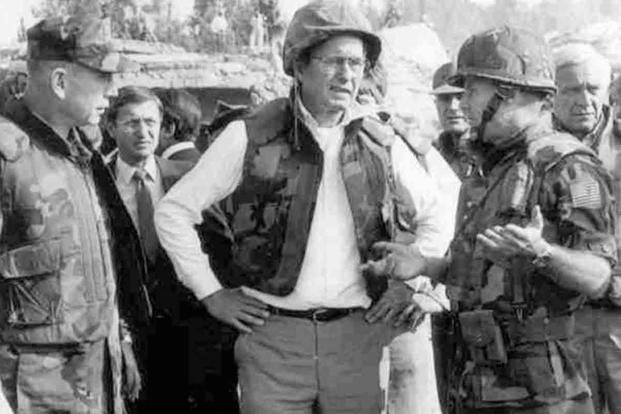Between 1975 and 1990, Lebanon was embroiled in a country-wide civil war that saw its rival religious, ethnic and nationalist populations form armed militias and shifting alliances. The fighting inflamed regional tensions and provoked international responses.
One of these was a peacekeeping mission of American, British, French and Italian forces called the Multinational Force in Lebanon (MNF). Deployed as part of an agreed cease-fire after a Palestine Liberation Organization (PLO) attack on Israel and Israel's subsequent invasion of Lebanon in 1983, the MNF spent almost a year and a half in the Lebanese capital.
The MNF was responsible for training the Lebanese military, restoring the country's central government in Beirut and overseeing the withdrawal of all foreign forces in Lebanon. A massive suicide bomber attack on the Marine Corps Barracks in October 1983 wiped away any success the MNF could claim, and led to the eventual withdrawal of American forces in March 1984.
Here are a few surprising, harrowing details about the Beirut Barracks Bombing.
1. The bomb was the largest non-nuclear explosion since World War II.
A truck filled with 12,000 pounds of TNT drove up to the American compound, crashed through the gates and into the Battalion Landing Team Headquarters building, where it exploded. According to the official Defense Department report on the bombing, the building itself was lifted from its foundation by the blast. It then imploded on itself. Those who survived the explosion were crushed or trapped by the rubble.
FBI investigators found the bomb was "gas enhanced," using bottles of oxygen and propane to introduce a gas multiplier effect, giving it more destructive power than a conventional explosive. In the final report, the FBI called it the "largest non-nuclear blast they've ever examined."
2. It was the single deadliest day for the U.S. military since the Tet Offensive.
On the first day of the 1968 Tet Offensive in the Vietnam War, 246 American troops were killed in the surprise attack. The death toll of the 1983 Beirut Barracks bombing would come close to matching that number, killing 220 Marines, 18 sailors and three U.S. soldiers -- 241 troops in all.

3. There were actually two suicide bombing attacks.
At almost the same time as the first truck was driving into the Marines' BLT headquarters, a second truck drove into the French Multinational Force Headquarters building. The destruction of the nine-story building killed 55 paratroopers from the 1st Parachute Chasseur Regiment and three from the 9th Parachute Chasseur Regiment. The French hadn't seen that kind of single-day losses since the end of the Algerian Revolution in 1962.
4. No one knows for certain who was responsible.
The official U.S. government report on the incident concludes the bombing "was a terrorist act sponsored by sovereign states or organized political entities for the purposes of defeating U.S. objectives in Lebanon." It doesn't say which entities are responsible.
A little-known group called Islamic Jihad claimed responsibility, but in a 2001 interview with PBS' "Frontline," former Secretary of Defense Caspar Weinberger reiterated that the U.S. didn't know who really perpetrated the attack.
In a 2003 lawsuit against the Islamic Republic of Iran, the U.S. District Court for the District of Columbia held that the Islamic Jihad was actually a front for Hezbollah, which is a "tool" of the Iranian government. The court held Iran responsible for the attack.
5. The CIA may have attempted revenge for the attack.
In March 1985, a 440-pound car bomb meant to kill Shia cleric Sayyed Mohammad Hussein Fadlallah, a spiritual inspiration for Hezbollah, exploded in Beirut. Fadlallah escaped the blast, but a number of his bodyguards were killed.
The bombing has been linked by writers and reporters to various organizations, including the CIA, CIA-backed militias in Lebanon, the Israeli intelligence agency Mossad and even Saudi Arabia. The truth behind the bombing may never be fully known, as it could have been just an attack from a rival group in the ongoing civil war at the time.
















